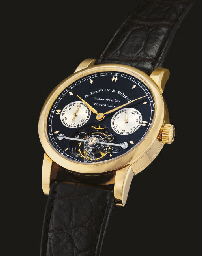A fine and rare Charles II walnut thirty-hour striking small hooded wall clock with alarm John Knibb, Oxford, circa 1685 The four finned pillar outside countwheel bell striking movement with plates measuring 6 by 3.5 inches and verge escapement regulated by short bob pendulum, the left hand side with transverse alarm mechanism sounding via a verge crown wheel and vertically pivoted yoke-shaped hammer on the inside of the hour bell set above the above the plates, the 5.5 inch square gilt brass dial with rose engraved silvered alarm disc and finely sculpted steel hand to the matted centre within applied silvered narrow Roman numeral chapter ring with typical Knibb type stylised fleur-de-lys half hour markers and quarter hour divided inner track, the angles with small applied winged cherub head spandrels and the lower edge signed John Knibb Oxon Fecit, the case with ogee moulded shallow-arch pediment incorporating foliate scroll pierced fret infill to the tympanum above fixed glazed dial aperture and rectangular side windows to the rising hood, with further cross-grain mouldings to the throat over shaped apron flanked by scroll outline side brackets beneath, the rectangular backboard with tongues for the rising hood, 35cm (13.75ins) high. Provenance: The property of a gentleman collector, purchased in these rooms on Wednesday 17th February 2010 (lot 69) for £37,000 hammer where it was noted that the clock was a recent discovery and believed to have formed part of a connoisseur collection of antiques and works of art compiled during the early 20th century. John Knibb was born in 1650 and was apprenticed to his older brother, Joseph, in around 1664. When Joseph moved to London in 1670 to set up business (presumably in the workshop inherited from his uncle, Samuel) John took on the Oxford workshop gaining the Freedom of the city on payment of a fine in 1673. Joseph Knibb retired in 1697 selling up most of his workshop before moving to Hanslop, Buckinghamshire where he made a few clocks prior to his death in 1711. John Knibb became a high profile figure within the City of Oxford twice becoming Mayor, he continued in business until his death in 1722. Due to the comparative rarity of clocks signed by John Knibb it has been suggested that his workshop may have generally served to supply Joseph's larger concern in London. The strong similarities between John's best work and those signed by Joseph would certainly support this view. However it is also clear that John was a high profile tradesman in the City of Oxford who trained no less than ten apprentices, therefore it is perhaps more likely that, although the two workshops were closely connected, they generally worked separately to supply clocks to differing groups of clients. The current clock belongs to a rare group of probably less than ten surviving examples of small hooded wall clocks from workshops of both John and Joseph Knibb Although these clocks were generally made for a common purpose, it seems that they do vary in detail and specification to the extent that no two are exactly the same. The majority of the other surviving examples appear have posted movements based on miniature lantern clocks with standard `Knibb` castings (see Lee, Ronald A. The Knibb Family * Clockmakers plate 178). The current lot is perhaps more unusual as it is constructed with a plated movement which can be compared to a simpler alarm timepiece by John Knibb illustrated by Lee (plate 179) as well as Darken, Jeff (ed.) HOROLOGICAL MASTERWORKS page 142. The inclusion of a striking train has necessitated the alarm mechanism to be located on a separate plate transversely mounted on the left hand side of the movement. The dial is particularly attractive with finely worked hand and narrow chapter ring. The case of perfect proportions and can be directly compared to a case housing a miniature lantern clock by Joseph Knibb illustrated by Lee, plate 59.
A fine and rare Charles II walnut thirty-hour striking small hooded wall clock with alarm John Knibb, Oxford, circa 1685 The four finned pillar outside countwheel bell striking movement with plates measuring 6 by 3.5 inches and verge escapement regulated by short bob pendulum, the left hand side with transverse alarm mechanism sounding via a verge crown wheel and vertically pivoted yoke-shaped hammer on the inside of the hour bell set above the above the plates, the 5.5 inch square gilt brass dial with rose engraved silvered alarm disc and finely sculpted steel hand to the matted centre within applied silvered narrow Roman numeral chapter ring with typical Knibb type stylised fleur-de-lys half hour markers and quarter hour divided inner track, the angles with small applied winged cherub head spandrels and the lower edge signed John Knibb Oxon Fecit, the case with ogee moulded shallow-arch pediment incorporating foliate scroll pierced fret infill to the tympanum above fixed glazed dial aperture and rectangular side windows to the rising hood, with further cross-grain mouldings to the throat over shaped apron flanked by scroll outline side brackets beneath, the rectangular backboard with tongues for the rising hood, 35cm (13.75ins) high. Provenance: The property of a gentleman collector, purchased in these rooms on Wednesday 17th February 2010 (lot 69) for £37,000 hammer where it was noted that the clock was a recent discovery and believed to have formed part of a connoisseur collection of antiques and works of art compiled during the early 20th century. John Knibb was born in 1650 and was apprenticed to his older brother, Joseph, in around 1664. When Joseph moved to London in 1670 to set up business (presumably in the workshop inherited from his uncle, Samuel) John took on the Oxford workshop gaining the Freedom of the city on payment of a fine in 1673. Joseph Knibb retired in 1697 selling up most of his workshop before moving to Hanslop, Buckinghamshire where he made a few clocks prior to his death in 1711. John Knibb became a high profile figure within the City of Oxford twice becoming Mayor, he continued in business until his death in 1722. Due to the comparative rarity of clocks signed by John Knibb it has been suggested that his workshop may have generally served to supply Joseph's larger concern in London. The strong similarities between John's best work and those signed by Joseph would certainly support this view. However it is also clear that John was a high profile tradesman in the City of Oxford who trained no less than ten apprentices, therefore it is perhaps more likely that, although the two workshops were closely connected, they generally worked separately to supply clocks to differing groups of clients. The current clock belongs to a rare group of probably less than ten surviving examples of small hooded wall clocks from workshops of both John and Joseph Knibb Although these clocks were generally made for a common purpose, it seems that they do vary in detail and specification to the extent that no two are exactly the same. The majority of the other surviving examples appear have posted movements based on miniature lantern clocks with standard `Knibb` castings (see Lee, Ronald A. The Knibb Family * Clockmakers plate 178). The current lot is perhaps more unusual as it is constructed with a plated movement which can be compared to a simpler alarm timepiece by John Knibb illustrated by Lee (plate 179) as well as Darken, Jeff (ed.) HOROLOGICAL MASTERWORKS page 142. The inclusion of a striking train has necessitated the alarm mechanism to be located on a separate plate transversely mounted on the left hand side of the movement. The dial is particularly attractive with finely worked hand and narrow chapter ring. The case of perfect proportions and can be directly compared to a case housing a miniature lantern clock by Joseph Knibb illustrated by Lee, plate 59.















Try LotSearch and its premium features for 7 days - without any costs!
Be notified automatically about new items in upcoming auctions.
Create an alert